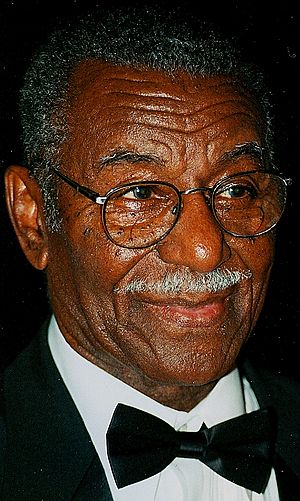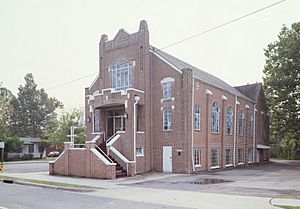Fred Shuttlesworth facts for kids
Quick facts for kids
Fred Shuttlesworth
|
|
|---|---|
 |
|
| 5th President of the Southern Christian Leadership Conference | |
| In office August – November 2004 |
|
| Preceded by | Martin Luther King III |
| Succeeded by | Charles Steele Jr. |
| Personal details | |
| Born |
Freddie Lee Robinson
March 18, 1922 Mount Meigs, Alabama, U.S. |
| Died | October 5, 2011 (aged 89) Birmingham, Alabama, U.S. |
| Resting place | Oak Hill Cemetery Birmingham, Alabama |
| Known for | Civil Rights Movement |
| Affiliations | Alabama Christian Movement for Human Rights (ACMHR) |
| Television | Eyes on the Prize (1987) Freedom Riders (2010) |
Frederick Lee Shuttlesworth (born Fred Lee Robinson, March 18, 1922 – October 5, 2011) was an important American civil rights leader. He fought against segregation (keeping people of different races apart) and other forms of racism. He was a minister in Birmingham, Alabama, a city known for its civil rights struggles.
Shuttlesworth helped start the Southern Christian Leadership Conference (SCLC) with Martin Luther King Jr. He also played a key role in the 1963 Birmingham campaign, which was a major effort to end segregation in Birmingham. Later, he moved to Cincinnati, Ohio, where he continued to work for civil rights and help people experiencing homelessness. He returned to Birmingham after he retired in 2007.
The Birmingham–Shuttlesworth International Airport was named after him in 2008. The Birmingham Civil Rights Institute also gives out an award in his name, called the Fred L. Shuttlesworth Human Rights Award.
Contents
Early Life and Activism
Fred Shuttlesworth was born in Mount Meigs, Alabama. In 1953, he became the pastor of the Bethel Baptist Church in Birmingham. He was also a leader in the National Association for the Advancement of Colored People (NAACP) in Alabama.
In 1956, the state of Alabama tried to stop the NAACP from operating. So, Shuttlesworth and Ed Gardner created a new group called the Alabama Christian Movement for Human Rights (ACMHR). This group continued the fight for equal rights. The ACMHR raised money from local meetings and used both lawsuits and direct actions to achieve its goals.
For example, when the city refused to hire Black police officers, the ACMHR sued. Also, after the Supreme Court of the United States ruled that bus segregation was illegal in Montgomery, Alabama, Shuttlesworth announced that the ACMHR would challenge segregation laws in Birmingham.
On December 25, 1956, someone tried to kill Shuttlesworth by placing dynamite under his bedroom window. His house was badly damaged, but he was not hurt. A police officer told him to leave town, but Shuttlesworth bravely replied that he was not leaving and "wasn't raised to run."
Education and Ministry
Fred Shuttlesworth was a smart student. He graduated as the top student from Rosedale High School. He went on to study at Selma University, earning his bachelor's degree in 1951. Later, he earned another degree from Alabama State University. Shuttlesworth became a licensed preacher when he changed from being a Methodist to a Baptist.
Southern Christian Leadership Conference
In 1957, Shuttlesworth helped found the Southern Christian Leadership Conference (SCLC). He started it with other important leaders like Martin Luther King Jr., Ralph Abernathy, and Joseph Lowery. The SCLC believed in nonviolence, meaning they would protest peacefully without using force. Their motto was: "Not one hair of one head of one person should be harmed."
Shuttlesworth strongly believed in nonviolence, even though he was a very determined and outspoken person. He sometimes disagreed with other civil rights leaders, even King, about the best ways to fight segregation. He often pushed King to take more action. In 1961, Shuttlesworth moved to Cincinnati, Ohio, to lead the Revelation Baptist Church. However, he remained very involved in the Birmingham campaign and often returned to help lead protests.
Freedom Rides
Shuttlesworth took part in the sit-ins against segregated lunch counters in 1960. He also helped organize the Freedom Rides in 1961. The Freedom Rides were journeys by civil rights activists on buses into the segregated Southern United States to challenge the lack of enforcement of the Supreme Court decisions.
Before the Freedom Rides began, Shuttlesworth warned that Alabama could be very dangerous. He respected the courage of the activists but felt there might be safer ways to advance the Civil Rights Movement. However, the Riders decided to go ahead with their plan.
Once the Freedom Rides were confirmed, Shuttlesworth worked with the Congress of Racial Equality (C.O.R.E.) to organize them. He was dedicated to making the Rides successful, especially when they came through Alabama. He encouraged other ministers to help the Riders. Many students involved in the Rides looked up to Shuttlesworth because of his strong commitment to ending segregation.
Project C in Birmingham
In 1963, Shuttlesworth invited the SCLC and Martin Luther King Jr. to Birmingham. He wanted them to lead a major campaign to end segregation there. He called this "Project C," with "C" standing for "confrontation." Shuttlesworth believed that city leaders would not end segregation unless they were forced to.
One protest he led in 1963 resulted in him being arrested for parading without a permit. His case went all the way to the US Supreme Court. In 1969, the Supreme Court overturned his conviction. They ruled that the city had denied the permit to stop the protest's message, not to control traffic.
Shuttlesworth wanted to create a situation that would force Birmingham's leaders to realize that segregation was too costly to maintain. This effort was greatly helped by Eugene "Bull" Connor, the city's Public Safety Commissioner. Connor used police dogs and fire hoses against peaceful young demonstrators, which was shown on television across the country.
These images shocked many Americans and helped turn public opinion against segregation. This public outcry played a big part in the passage of the Civil Rights Act of 1964, which outlawed segregation.
Shuttlesworth's work wasn't just in Birmingham. In 1964, he went to St. Augustine, Florida, where he joined marches and protests against segregation. In 1965, he was active in the Selma Voting Rights Movement, including the Selma to Montgomery marches. These marches led to the passage of the Voting Rights Act of 1965, which protected the right to vote for all citizens. Shuttlesworth played a key role in achieving these two major civil rights laws.
Later Years and Legacy
In 1966, Shuttlesworth started the Greater New Light Baptist Church. He also founded the "Shuttlesworth Housing Foundation" in 1988. This foundation helped families who might not otherwise be able to buy their own homes.
In 1998, he supported the Birmingham Pledge, a community effort to fight racism. Also in 1998, South Crescent Avenue in Cincinnati was renamed in his honor.
On January 8, 2001, President Bill Clinton gave him the Presidential Citizens Medal. In August 2004, he became president of the Southern Christian Leadership Conference, but he resigned later that year. In 2004, Shuttlesworth received an award for his great public service to disadvantaged people.
Family Life
Fred Shuttlesworth was born Freddie Lee Robinson. He took the last name of his stepfather, William N. Shuttlesworth, who worked as a coal miner. His mother, Alberta, lived to be 95 years old.
Fred Shuttlesworth was married to Ruby Keeler Shuttlesworth. They had four children: Patricia, Ruby, Fred Jr., and Carolyn. They divorced in 1970, and Ruby passed away the following year.
Retirement and Passing

After having a brain tumor removed, Fred Shuttlesworth gave his final sermon on March 19, 2006, just after his 84th birthday. He and his second wife, Sephira, moved to Birmingham for his medical care.
On July 16, 2008, the airport in Birmingham, Alabama, was renamed the Birmingham–Shuttlesworth International Airport in his honor.
Fred Shuttlesworth passed away on October 5, 2011, at the age of 89 in Birmingham. The Birmingham Civil Rights Institute plans to include his burial site on the Civil Rights History Trail. The governor of Alabama ordered flags on state buildings to be lowered to half-staff to honor him. He is buried in the Oak Hill Cemetery in Birmingham.
See also


